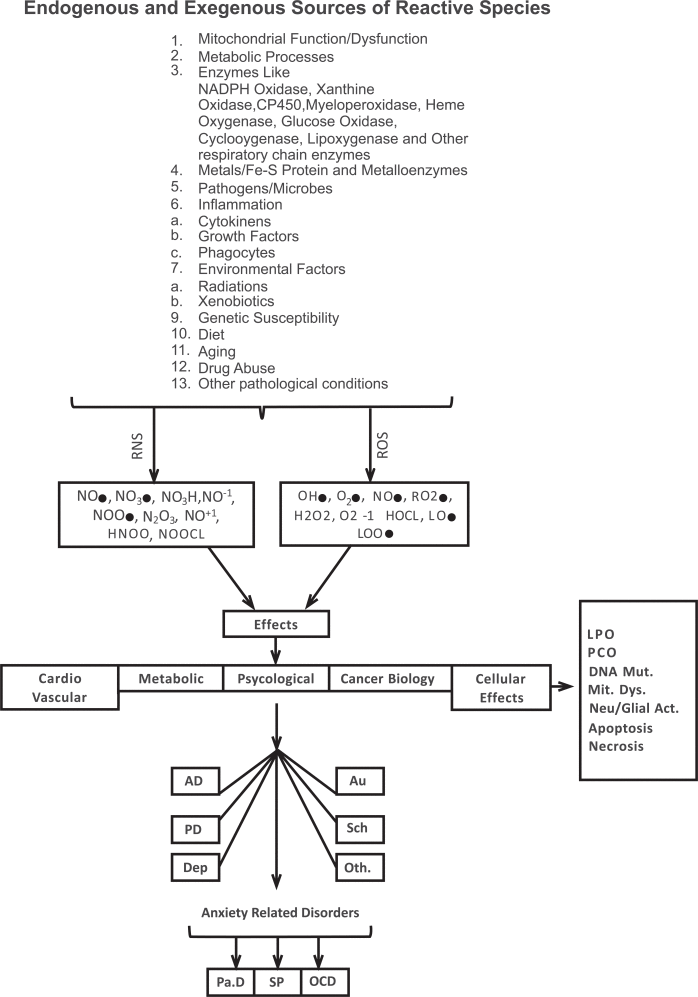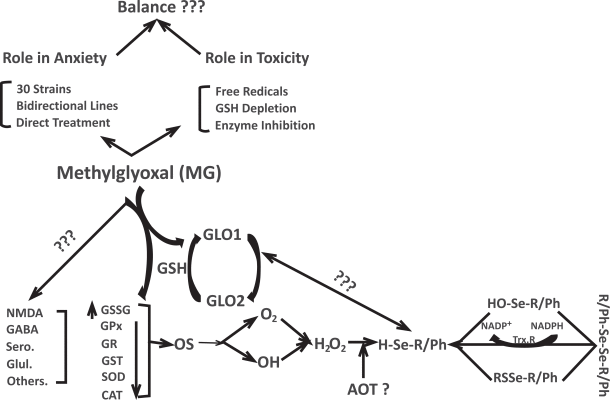Association of oxidative stress to the genesis of anxiety: implications for possible therapeutic interventions
- PMID: 24669207
- PMCID: PMC3964744
- DOI: 10.2174/1570159X11666131120232135
Association of oxidative stress to the genesis of anxiety: implications for possible therapeutic interventions
Abstract
Oxidative stress caused by reactive species, including reactive oxygen species, reactive nitrogen species, and unbound, adventitious metal ions (e.g., iron [Fe] and copper [Cu]), is an underlying cause of various neurodegenerative diseases. These reactive species are an inevitable by-product of cellular respiration or other metabolic processes that may cause the oxidation of lipids, nucleic acids, and proteins. Oxidative stress has recently been implicated in depression and anxiety-related disorders. Furthermore, the manifestation of anxiety in numerous psychiatric disorders, such as generalized anxiety disorder, depressive disorder, panic disorder, phobia, obsessive-compulsive disorder, and posttraumatic stress disorder, highlights the importance of studying the underlying biology of these disorders to gain a better understanding of the disease and to identify common biomarkers for these disorders. Most recently, the expression of glutathione reductase 1 and glyoxalase 1, which are genes involved in antioxidative metabolism, were reported to be correlated with anxiety-related phenotypes. This review focuses on direct and indirect evidence of the potential involvement of oxidative stress in the genesis of anxiety and discusses different opinions that exist in this field. Antioxidant therapeutic strategies are also discussed, highlighting the importance of oxidative stress in the etiology, incidence, progression, and prevention of psychiatric disorders.
Keywords: Antioxidant therapy; anxiety disorders; oxidative stress; toxicity..
Figures



Similar articles
-
The differential diagnosis of anxiety. Psychiatric and medical disorders.Psychiatr Clin North Am. 1985 Mar;8(1):3-23. Psychiatr Clin North Am. 1985. PMID: 3887337 Review.
-
Glyoxalase 1 and glutathione reductase 1 regulate anxiety in mice.Nature. 2005 Dec 1;438(7068):662-6. doi: 10.1038/nature04250. Epub 2005 Oct 23. Nature. 2005. PMID: 16244648
-
Childhood sexual abuse and psychiatric disorders in middle-aged and older adults: evidence from the 2007 Adult Psychiatric Morbidity Survey.J Clin Psychiatry. 2012 Nov;73(11):e1365-71. doi: 10.4088/JCP.12m07946. J Clin Psychiatry. 2012. PMID: 23218165
-
Oxidative stress and anxiety: relationship and cellular pathways.Oxid Med Cell Longev. 2009 Apr-Jun;2(2):63-7. doi: 10.4161/oxim.2.2.7944. Oxid Med Cell Longev. 2009. PMID: 20357926 Free PMC article. Review.
-
Redox- and non-redox-metal-induced formation of free radicals and their role in human disease.Arch Toxicol. 2016 Jan;90(1):1-37. doi: 10.1007/s00204-015-1579-5. Epub 2015 Sep 7. Arch Toxicol. 2016. PMID: 26343967 Review.
Cited by
-
Regulation of Reactive Oxygen Species-Mediated Damage in the Pathogenesis of Schizophrenia.Brain Sci. 2020 Oct 16;10(10):742. doi: 10.3390/brainsci10100742. Brain Sci. 2020. PMID: 33081261 Free PMC article. Review.
-
Increasing Inhibition of the Rat Brain 2-Oxoglutarate Dehydrogenase Decreases Glutathione Redox State, Elevating Anxiety and Perturbing Stress Adaptation.Pharmaceuticals (Basel). 2022 Jan 31;15(2):182. doi: 10.3390/ph15020182. Pharmaceuticals (Basel). 2022. PMID: 35215295 Free PMC article.
-
Most Effective Combination of Nutraceuticals for Improved Memory and Cognitive Performance in the House Cricket, Acheta domesticus.Nutrients. 2021 Jan 25;13(2):362. doi: 10.3390/nu13020362. Nutrients. 2021. PMID: 33504066 Free PMC article.
-
Subcortical gray matter volumes in asthma: associations with asthma duration, control, and anxiety.Brain Imaging Behav. 2020 Dec;14(6):2341-2350. doi: 10.1007/s11682-019-00188-3. Brain Imaging Behav. 2020. PMID: 31501976 Free PMC article.
-
Anxiolytic properties of compounds that counteract oxidative stress, neuroinflammation, and glutamatergic dysfunction: a review.Braz J Psychiatry. 2019 Mar-Apr;41(2):168-178. doi: 10.1590/1516-4446-2018-0005. Epub 2018 Oct 11. Braz J Psychiatry. 2019. PMID: 30328963 Free PMC article. Review.
References
-
- Inoue M, Sato EF, Nishikawa M, Park AM, Kira Y, Imada I, Utsumi K. Mitochondrial generation of reactive oxygen species and its role in aerobic life. Curr. Med. Chem. 2003;10:2495–2505. - PubMed
-
- Bergendi L, Benes L, Duracková Z, Ferencik M. Chemistry physiology and pathology of free radicals. Life Sci. 1999;65:1865–1874. - PubMed
-
- Valko M, Izakovic M, Mazur M, Rhodes CJ, Telser J. Role of oxygen radicals in DNA damage and cancer incidence. Mol. Cell. Biochem. 2004;266:37–56. - PubMed
-
- Gupta M, Dobashi K, Greene EL, Orak JK, Singh I. Studies on hepatic injury and antioxidant enzyme activities in rat subcellular organelles following in vivo ischemia and reperfusion. Mol. Cell. Biochem. 1997;176:337–347. - PubMed
LinkOut - more resources
Full Text Sources
Other Literature Sources
Research Materials
